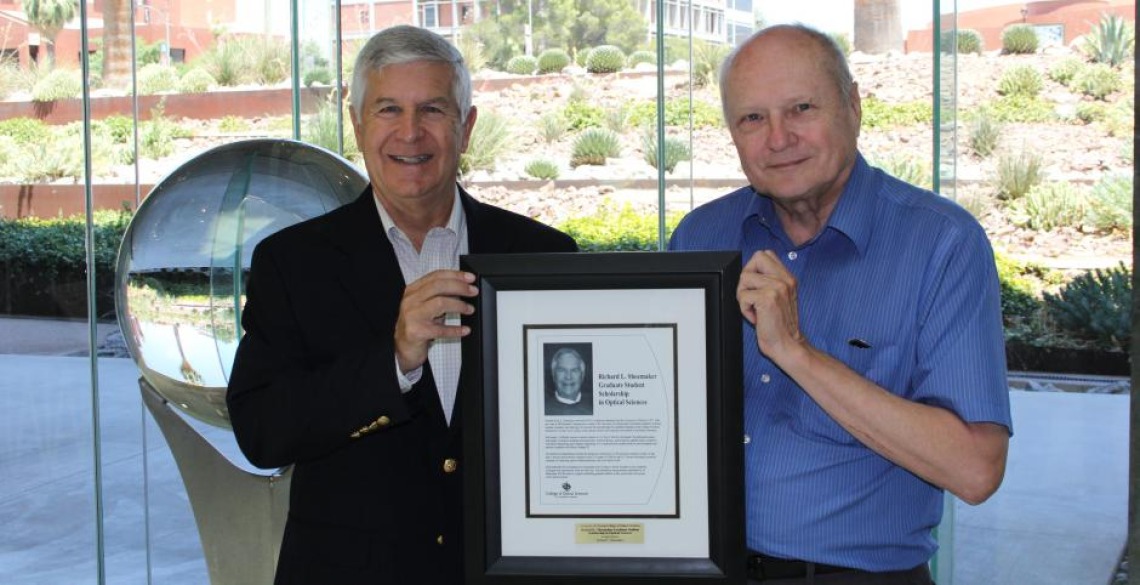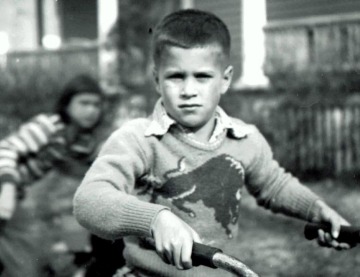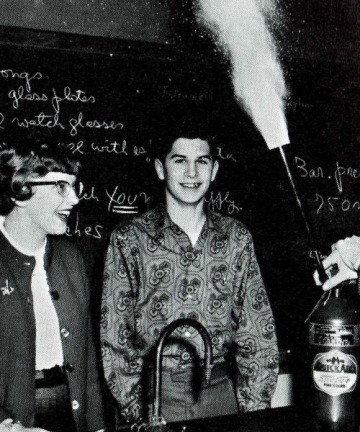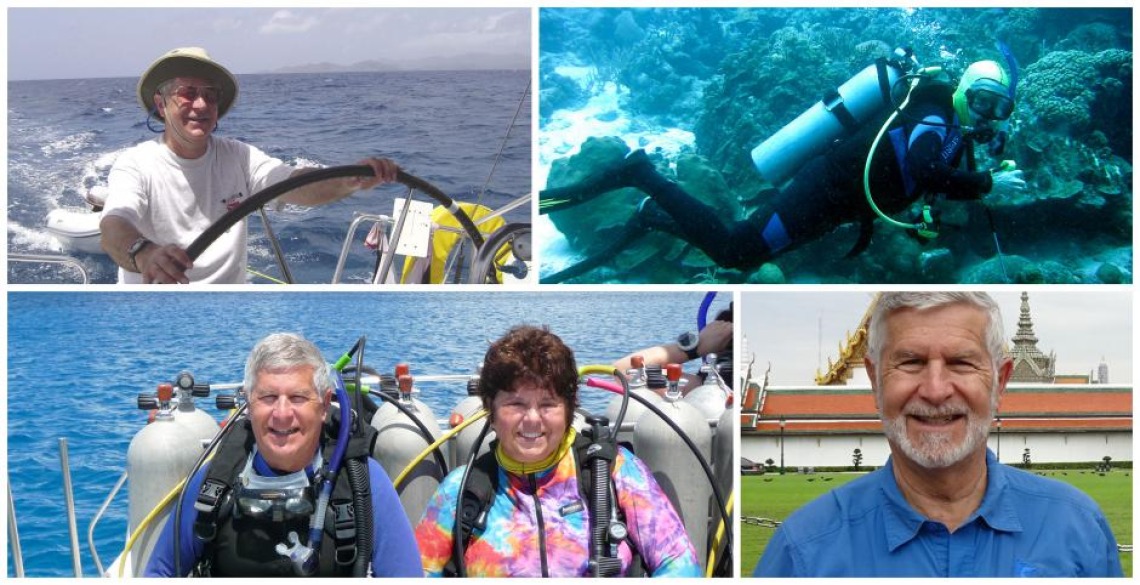Reflections: Richard L. Shoemaker

The presentation of the Richard L. Shoemaker Graduate Student Scholarship in Optical Sciences.
As a high school senior in Grand Rapids, Michigan, Professor Emeritus Richard (Rick) L. Shoemaker thought he knew exactly what he wanted to do with his life. His path was not only clear, but also well-paved. He had just received a National Merit Scholarship, enabling him to major in chemistry at Calvin College—after which he imagined himself pursuing a Ph.D. in chemistry, then working in a lab for a chemical company. Fifty-seven years later—after a career encompassing chemistry, optical physics, computer engineering, teaching, and academic administration—Rick advises students to “embrace the non-linear journey to figuring out what they want to do with the rest of their lives.”
Early Life

Born on Dec. 31, 1944, to Les and Gerri Shoemaker, Rick grew up in Grand Rapids, Michigan. In junior high school, he became very interested in chemistry and set up his own chemistry lab in the basement of his house. While most of the chemicals were harmless, some would make even the most lenient modern-day parent nervous. Rick recalls making “synthetic rubber, nylon and a variety of explosives—back then, anyone could order any sort of chemicals by mail, no questions asked!”
Rick’s desire to become a scientist was solidified after his senior year in high school when he was selected to attend the 1962 Honors Institute for Young Scientists (HIFYS)—a competitive scholarship program for high school juniors and seniors. Administered by the University of Michigan and supported by a National Science Foundation grant, the Institute offered six weeks of enriched high school science courses with an opportunity for independent study in mathematics, physics or chemistry. For his final project, Rick successfully constructed a diffusion-type cloud chamber.
Education and Early Career

Thanks to a National Merit Scholarship, Rick was able to major in chemistry at Calvin College (now, Calvin University)—a private Christian liberal arts university in Grand Rapids. Upon graduating, he enrolled in graduate school at the University of Illinois, where he worked with W. H. Flygare on Zeeman effects in microwave spectroscopy and microwave-optical double resonance spectroscopy.
After being awarded a Ph.D. in physical chemistry in January, 1971, Rick interviewed at Eastman Kodak in Rochester, New York, but decided, instead, to join IBM’s Research Laboratories in San Jose, California, as a visiting scientist. “When I arrived in Rochester for my interview, it was 30 degrees and snowing. The next day I interviewed in San Jose—with sunny skies and a temperature of 75 degrees. Weather was not the only reason I chose to work for IBM—but it certainly helped.”
At IBM, Rick worked with R. G. Brewer in the area of laser spectroscopy—co-developing the Stark switching technique for observing optical coherent transient effects. According to Rick, “it was one of those rare events where an experiment not only worked the first time it was put together, but also worked far better than expected.”
From Chemistry to Optics
Two events led Rick to the field of optics, and to the College of Optical Sciences (OSC) at the University of Arizona. The first was meeting former OSC director Peter Franken, then a professor of physics at the University of Michigan.
As part of the Honors Institute program, we traveled to the University of Michigan where we attended lectures given by the leading scientists on the faculty. One of those scientists was Professor Peter A. Franken, who explained—in his inimitable style—how lasers worked. He gave us an impressive demonstration of his ruby laser, measuring its output in “Gillettes,”—the number of razor blades the laser could punch a hole through.
The second event was as a result of working with Richard Brewer at IBM. The novel technique they developed—for observing photon echoes and many other optical coherent transient phenomena—caught the attention of the quantum optics group at OSC.
In March 1972, the quantum optics group at OSC invited me to interview for a position as an assistant professor. I was excited about this new opportunity, but had no idea what the Sonoran Desert around Tucson looked like. Somehow, I had this idea in my head that it looked more like the Sahara, nothing but sand and maybe a few tumbleweeds. I was pleasantly surprised when I arrived.
I gave a talk entitled, “A Novel Technique for Studying Transient Coherent Optical Effects.” After meeting with Aden Meinel, then-director of OSC, I headed to Sabino Canyon with the quantum optics group for a picnic. It was there that professor Marlan Scully presented me with an offer to join their group—behind the bushes at the picnic site.
College of Optical Sciences
For the first few years at OSC, Rick continued his research in laser spectroscopy and optical coherent transient effects in atoms and molecules. In 1976, nominated by OSC Director Peter A. Franken, he was awarded a Sloan Research Fellowship—given annually by the Alfred P. Sloan Foundation to “provide support and recognition to early-career scientists and scholars.”
Later, Rick became interested in parallel computers, image processing, and laboratory and biomedical computing. Since his days as a grad student, he had been capitalizing on using computers in the laboratory to automate data acquisition and analysis. In 1977—shortly after the first microprocessor chips became available—Rick designed and built his own microcomputer from parts; wrote a basic monitor program for it in machine language (there was not an assembler or compiler available for it at the time); and debugged the hardware and software using only a voltmeter. Once microcomputers became commercially available, he started using them in his lab to improve and automate data collection.
Seeing the widespread interest in using microcomputers in the laboratory, Rick and fellow OSC professor Murray Sargent III designed and taught a course on microcomputers for OSC graduate students (the first such course at the University). One of their high points of teaching this course was having Nobel Laureate Willis Lamb sit in on the class for an entire semester. Rick remembers “it was always intimidating to discuss physics with Willis, but computers were a new subject for him and I think he really enjoyed being the ‘student’—not expected to know all the answers.”
Rick and Murray also decided to write a book entitled Interfacing Microcomputers to the Real World. Later, they would write two more books together, The IBM Personal Computer from the Inside Out andThe Personal Computer from the Inside Out.
Multiprocessor Computers at OSC
In the early 1980s, Rick began working with fellow OSC professor Peter Bartels on a long-term project to explore the capabilities of multi-microprocessor computers for analyzing the massive amounts of histopathologic data that can be produced by devices such as the ultrafast Shack/Bartels laser scanner. The initial computer system used was a custom-built 4-processor system using Motorola 68000s—the Heidelberg Polyprocessor (POLYP) developed by J. Bille and R. Manner. This was later replaced by a 6-processor system using commercial MC68020 processors interconnected by a VME bus.
In 1989, Rick constructed one of the first large-scale parallel computers at the University of Arizona—a 60-processor transputer-based system for image reconstruction in nuclear medicine, called TRIMM (Transputer Implementation of Monte Carlo Methods). The system had several unique features including four high-speed interconnects on each processor—allowing them to be connected together into a mesh, ring, or other network topologies. It also had a global broadcast address mode via a common VME bus interface.
Harry Barrett asked me if I could build a multiprocessor computer to do the front-end processing for a novel coded-aperture detector system he was developing for nuclear medicine. I designed, built and debugged the hardware. I also wrote the initial operating system software for this 60-processor computer system. Despite the fact that it took nearly six months to debug the hardware, it was a tremendously enjoyable and satisfying experience.
Ingenuity at Its Finest
During those early years at OSC, Rick and Murray demonstrated imagination—not only in physics and microcomputers—but also in general building improvements. As the original optical sciences building had very few dedicated collaborative spaces, the quantum optics group commandeered the hallway on the sixth floor for their lively discussions. Many complicated problems were debated using small pieces of scrap paper covered in equations that were passed among them. Before long, the need for blackboards became quite apparent.
A request was sent to UA Facilities Management for two blackboards be installed in the hallway. When the answer was “no,” Rick and Murray, decided to take matters into their own hands. Being cleverly resourceful, they were able to procure a couple of surplus blackboards which they mounted to the wall on the sixth floor one weekend. The following Monday, the janitorial staff cleaned the boards as if they were supposed to be there and the rest, as they say, is history. More than 30 years later, the two boards are still hanging.
On a later occasion, professor Jim Small had a new PDP-11 minicomputer installed in a 2nd floor lab, which Rick and Murray were allowed to access. Unfortunately, the only connection available to the computer was via 300 baud (30 characters per second) telephone modems.
Murray and I took Peter Franken’s advice that ‘it’s easier to ask for forgiveness than to ask for permission.’ We went into the telephone wiring closet and rewired an obsolete intercom system that connected every room in the building. This gave us a direct connection between our offices and the PDP-11, and a connection speed that was over 30 times faster.
Academic Administration
Since the Center’s founding, the Academic Programs (formerly, Academic Affairs) office has been supported by excellent staff who have conscientiously advised students throughout their programs of study. In 1993, the associate director of Academic Affairs, Jack Gaskill, stepped down and OSC Director Richard C. Powell asked Rick to “take on a new challenge.”
During Rick’s 14 years as the associate director—then, later, associate dean—of Academic Programs, he was involved in many significant changes. Much of the academic office’s paperwork was moved to computers, and a centralized database was set up for the Fred A. Hopf Reading Room. OSC created its first web pages with Rick as webmaster, and the academic office took on the task of organizing and running the 2-day Industrial Affiliates workshop held every year. This workshop has continued to be a very successful event.

The presentation of the Richard L. Shoemaker Graduate Student Scholarship in Optical Sciences.
Graduate student recruitment efforts were greatly expanded. In 1996, the New Student Recruitment Weekend was created—with top applicants being flown to Tucson for a 2-day visit. This significantly increased the number of high-quality graduate students OSC has been able to attract. Additionally, a large number of optics courses became available by video—allowing MS students to complete nearly all of their degree requirements without having to be physically on campus.
Under Rick’s guidance, the number of undergraduate students in the Optical Engineering program increased greatly, and the number of courses offered nearly doubled. After administration of the program was transferred to OSC from Electrical and Computer Engineering (ECE) in 2000, Rick led the successful effort to gain accreditation for the program from ABET—the primary agency that accredits engineering programs in the United States. Aside from a small program at the University of Alabama, Huntsville, OSC was the first major undergraduate optics program in the country to be ABET accredited.
Teaching and Professional Society Involvement
While he was head of Academic Programs, Rick continued to teach courses every semester. Over the years, he taught 12 different courses on lasers, quantum mechanics, computer interfacing, and electronics—five of these being laboratory courses.
Rick also was significantly involved with The Optical Society (OSA)—serving on numerous committees, including twice on the Board of Directors. He also served as co-chair of the 2002 OSA Annual Meeting, and was elected an OSA Fellow.
I found my involvement with OSA to be a very rewarding activity, which provided opportunities to interact and work with many of the most important figures in 20th century optics. A highlight was being on the ad hoc committee that created the first open access optics journal, “Optics Express.”
Retirement
After 38 years at OSC, Rick retired to enjoy traveling, scuba diving, hiking and birding with his late wife, Yolanda. They visited over 25 countries and made over 300 scuba dives, in locations that included Hawaii, Fiji, the Cook Islands, Australia, Belize, Turks and Caicos, Rotan and Himalaya Bay. Together, they hiked the Austrian and Swiss Alps and the Yosemite High Sierra loop. They also learned to sail and did a number of bareboat charters out of San Diego, Ft. Myers, Santa Barbara, Traverse City, the British Virgin Islands and St. Vincent & the Grenadines. While Rick usually was the captain of record, Yolanda reserved the right to be the admiral, and gave Rick a tee shirt that read, “I am the captain because my wife said I could be.”
At home, Rick stays fit by hiking in Sabino Canyon and taking body conditioning and Zumba classes five to six days a week. He also enjoys building 1/10 scale robotic cars and programming them to drive themselves, using electronics he designed and built—three microprocessors, optical time-of-flight distance sensors, wheel encoders, an inertial measurement unit, and a video camera.

From Top L to R: Rick sailing in the British Virgin Islands, Rick scuba Diving in the Turks & Caicos
From Bottom L to R: Rick & Yolanda scuba diving in the Turks & Caicos, Rick in Bangkok, Thailand.
In April, Rick plans to share his love of the water with his entire family. Rick, his girlfriend Barb, his three sons, their wives and significant others, and his four grandchildren will embark on a Caribbean cruise. “We thought an organized cruise on a large ship would be best for everyone, including the youngest. But, to introduce them to bareboat sailing, I’ve chartered a 48 ft. catamaran for a day to set sail from St. Thomas at the end of our cruise.”
(Editor’s Note: In 2014, Rick established the Richard L. Shoemaker Graduate Student Endowed Scholarship in Optical Sciences. This scholarship is open to first-year graduate students who demonstrate a commitment to scholarship, involvement in extracurricular activities, and interests beyond science and technology.)
